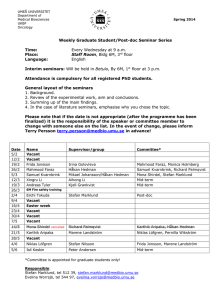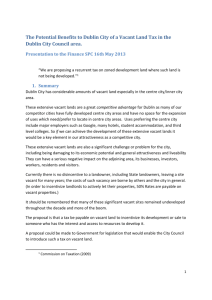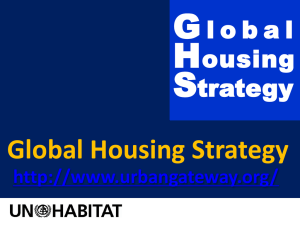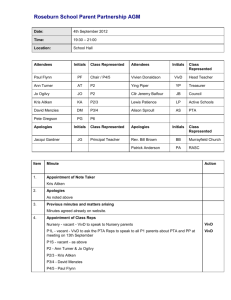Implementing a Land Value Tax in Urban Residential Communities
advertisement
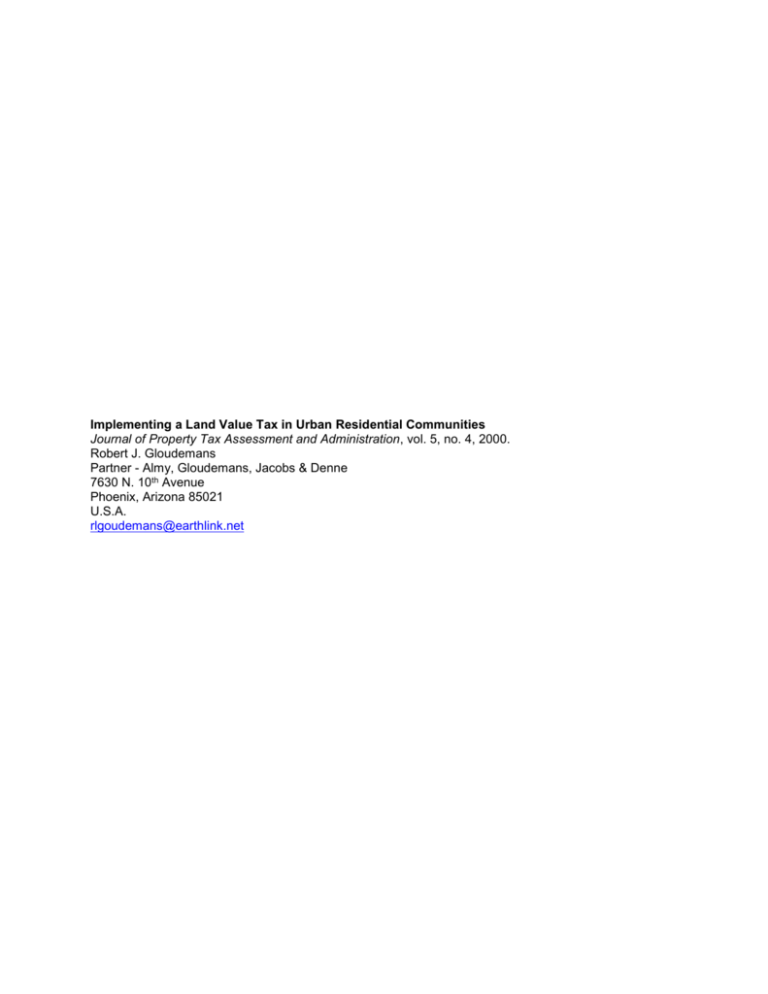
Implementing a Land Value Tax in Urban Residential Communities Journal of Property Tax Assessment and Administration, vol. 5, no. 4, 2000. Robert J. Gloudemans Partner - Almy, Gloudemans, Jacobs & Denne 7630 N. 10th Avenue Phoenix, Arizona 85021 U.S.A. rlgoudemans@earthlink.net Abstract This paper describes the results of a research project conducted under a John C. Lincoln Fellowship for the Lincoln Institute of Land Policy (Cambridge, Massachusetts, USA) on the potential for modern mass appraisal methods to separate values for residential properties between land and buildings. The Lincoln Institute has had a long-standing interest in land use and policy, including a land value tax. The research project involved an empirical determination of the feasibility of using multiple regression analysis (as well as the adaptive estimation procedure or “feedback”) to decompose estimated residential property values between land and improvements. Both vacant and improved residential sales data were obtained from three North American communities. As a benchmark, a traditional additive model was developed for each community using the improved sales only. Using both vacant and improved sales, a nonlinear model separable into land and building components was then developed. A comparison of results revealed that a combined model built from both vacant and improved sales need not sacrifice predictive accuracy for improved properties. Analysis of land and building values from the nonlinear models suggests that land may constitute a higher percentage of total value for residential properties than commonly believed, in part because of a potential premium in value for improved over vacant sites. Tax shift analyses indicate that implementation of a land value tax would be less advantageous to lower-value than higher-value residential properties. 1. Introduction Well over half the property tax base in most communities is attributable to residential land and buildings. In many urban areas most land has been improved and there are no or relatively few vacant land sales to help develop land values. From the perspective of a land value tax, this reality creates practical difficulties in determining land values, particularly for built-on land. At the same time, assessment jurisdictions worldwide have made great strides in the last twenty years in using statistical analyses to estimate total values (land plus buildings). This paper explores the possibility of using modern mass appraisal techniques to develop separate estimates of land and building values for residential properties, and analyzes the tax shifts inherent in implementation of a land tax. The research analyzed data from three large North American metropolitan areas: Ada county (Boise), Idaho; Edmonton, Alberta; and Jefferson county (suburban Denver), Colorado. Each jurisdiction provided the author with sales for both vacant and improved residential sales from a multi-year period for purposes of the analysis. The data included sale price and date, location, improvement characteristics, land size, and available site characteristics. In each case, a traditional “additive” multiple regression model, similar to that used by assessment authorities, was developed and the accuracy of the results analyzed in terms of ability of the model to predict actual sales prices. Next, a “hybrid” model using nonlinear regression analysis was developed for the vacant and improved sales combined. Unlike additive models, nonlinear models have no constant and can be decomposed into land and building values (they are also more flexible in specification and can accommodate both dollar-per-unit and percentage adjustments). Results of the nonlinear models were tested on the combined sales and separately on the improved and vacant land sales. Finally, estimated values were separated between land and building components and tax shifts inherent in phase-in of a site value tax analyzed. This analysis included a determination of the tax impact on both vacant and improved land, as well as relative winners and losers among improved properties in terms of land area, house size, building age, construction quality, neighborhood, and value range. This paper describes the analyses for the Clareview (Edmonton) data and compares results to those obtained for the other two databases. Section 2 below describes the Clareview database, section 3 presents results for the additive model using improved sales, section 4 contains the nonlinear model results for vacant and improved sales combined, section 5 presents the tax shift analysis, and section 6 summarizes results and conclusions based on the analyses conducted for all three communities. 2. Clareview (Edmonton) Database The City of Edmonton, Alberta is divided into twelve market areas for residential modeling purposes. Clareview is one of the largest. Located on the City’s north side, it is a steadily growing area comprised of predominately standard and semi-custom built homes. The area was chosen because it has many vacant land sales, although about half of neighborhoods in the area are virtually fully developed with no remaining vacant lot sales. The City of Edmonton provided a data file of all validated vacant and improved residential sales that occurred in the Clareview market area over the period, July 1996 through June 1999, which is the same sales period used to develop the City’s assessment year 2000 models. In conformance with Alberta statutes, the City updates values annually based on the current market. There were 3,482 improved and 900 vacant (20.5 percent) residential sales suitable for analysis over the 3-year period. Figures 1(a) and 1(b) contain a histogram of sales prices and a bar charts of median sales prices by neighborhood for the improved sales. Figures 2(a) and 2(b) contain comparable summaries for the vacant land sales. Overall, the average sale price is $124,179 for the improved sales and $43,849 for the vacant lots (1 Canadian dollar equals approximately 0.73 Euro dollar and 0.67 U.S. dollars). In both cases, sales prices vary considerably among neighborhoods (notice that only 17 of the neighborhoods are represented by vacant lot sales). /// Insert figures 1 and 2 about here /// Figure 3 contains descriptive statistics for the improvement related variables and lot size. Available Improvement characteristics include construction quality, design type (MBC or market building class), roof type, heating type and air conditioning (Y/N), year built and effective year built, fireplaces, main living area, total and finished basement areas, garage and carport sizes, and secondary areas and features (such as solariums, loft areas, and swimming pools). The average main living area is 120 square meters (all sizes are in metric). In addition, virtually all the homes have basements, of which about three-fourths are fully or partially finished. The homes were all built in the 1950s or later with the average being 1981. The average lot size is approximately 550 square metes (median size is 540 square meters). /// Insert figure 3 about here /// Figure 4 shows the distribution of selected site characteristics. Commonly found features in Clareview include lake, river, ravine, park, traffic, commercial, multi-family, and institutional influences. Note that valuers rate these influences as 0 (none), 1 (moderate), 2 (strong), or 3 (very strong). /// Insert figure 4 about here /// 3. Additive Model – Improved Properties An additive model using stepwise regression analysis for the 3,482 improved sales in the market area was developed patterned after the City’s most recent model for the 2000 assessment year. Figure 5 contains the model results. Improvement variables important in the model include living area (one variable per quality class), lower level and basement areas, attached and detached garages, the square root of age (multiplied by square meters of living area), fireplaces, and binary variables for design types, all brick exterior, and premium (tile) roof. Of several lot size variables tested, the log of lot size (LOGLSIZE) produced the best fit. Site variables were included for lake, river, ravine, park, traffic, and multi-family influences. The time variable enters at $2.18 per square meter per month, suggesting modest price appreciation of 0.2% per month (2.18 x average living area of 120 square meters ÷ average sale price of $124,179). A binary variable for sales occurring in the winter (November through February) is strongly significant with a coefficient of -$2,674. Twenty of thirty-three neighborhood binaries entered significantly (neighborhood 2410 served as the base neighborhood). The model produces an overall median ratio of 1.0006 and an excellent average error as measured by the coefficient of dispersion (COD) of 5.87. Comparable CODs were 8.82 in Ada County, for which land variables other than land size and broad market areas were not available, and 5.75 in Jefferson County, where variables were similar to those in Clareview. In all three communities, a further analysis of the resulting ratios showed strong equity with respect to lot size, living area, construction quality, age, location, and other relevant characteristics. /// Insert figure 5 about here /// 4. NLR Combined Model – Vacant and Improved Properties A non-linear regression (NLR) analysis using the 3,482 improved sales and 899 vacant land sales (one vacant lot sale with incomplete data was dropped from the analysis) was run to develop land and building values. The model took the following format: V = GQ * ((LA * LQ) + ( BA * BQ)) where GQ = product of global qualitative factors (time and winter). LA = sum of land additive components = (Bi * NBHDi) * (LOTSIZE/540)^LSIZE_EXP. Note: NBHDi are neighborhood binaries, Bi are their corresponding coefficients (base lot values), and 540 is the typical lot size (square meters). LQ = product of land qualitative factors (lake, river, ravine, park, traffic, and multi-family). In addition, a binary variable was specified for improved parcels to represent the incremental value (if any) of improved versus vacant land. BA = sum of building additive components (main living area, total and finished basement areas, lower level area, attached and detached garage areas, and fireplaces). To account for possible economies of scale, both a coefficient and exponent were specified for main living area: B1 * LIVAREA^BSIZ_EXP. BQ = product of building qualitative factors (construction quality, design, all brick exterior, tile roof, and percent good). Exhibit 6 contains the results of the NLR model. The R-square is .9507. Note the following: 1) Main living area is calibrated as 1428 * LIVAREA.788. Thus for example, a 150 square meter home would have an initial value of: 1428 * 1500.788 = 74,043 or 494 per square meter. 2) The percent good multipliers, initially specified as 1-age/100, are expanded: Percent Good = (1-AGE/100)1.69. Thus, a 20 year old home would have a multiplier of: (1-20/100)1.69 = 0.686. 3) 4) 5) 6) 7) Lake is the strongest location factor with a type 3 rating (88 sales) taking on a multiplier of 1.335 (1.1013). Over 1,000 sales are affected by traffic with multipliers of .967 for level 1 to .904 for level 3 (.9673). Base values for a 540 square meter lot (median) range from $33,085 (neighborhood 120) to $47,201 (neighborhood 400). The land size exponent is .286. Thus, for example, a 1,000 square meter lot in neighborhood 400 would have an initial value, before adjustment for GQ and LQ factors, of LV = 47,201 * (1000/540).286 = 56,297. The GQ factors for time and winter are very similar to those suggested by the additive model. The factor for improved land is 1.35, suggesting a 35% premium for comparable improved over vacant land. /// Insert figure 6 about here /// The model produces a median sales ratio of 1.0007 and a COD of 6.77. The COD for the improved sales is 5.97, just slightly above the COD of 5.87 for the additive model developed from improved sales alone. For vacant land, the COD is 9.85, also very good. For all three databases analyzed, results were as follows (recall that there were no site variables and only broad geographic areas for Ada County): Clareview Ada County Jefferson County Sales Used in NLR Model Percent Vacant Overall COD Improved only COD Vacant only COD 4,381 20.5 15,005 14.1 6.77 5.97 9.85 4,836 4.5 10.54 8.99 18.70 6.64 5.55 15.31 Figures 7(a), 7(b), and 7(c) present graphs of the ratios for the vacant lot sales against lot size, value, and neighborhood, respectively. The scatter plots of the ratios with lot size and value both show good equity. However, while generally good, the box plot of the ratios by neighborhood indicates that in some neighborhoods ratios are generally low (neighborhoods 2130 and 2280) and in others they are generally high (2500 and 2720). (In a box plot, the box represents the interquartile range and the dark line in the box is the median). This suggests that premiums for built-on land may vary, perhaps with the level of site improvements, landscaping, and the like. /// Insert figure 7(a), 7(b), and 7(c) about here /// 5. Shift Analysis As shown in figure 8, the total estimated value of all 4,381 sales used in the analysis was $513.5 million, of which 181.5 million, or 35% is estimated to be land value (the corresponding percentage for improved property only is 30%). Thus, if the sales were representative of the general distribution of values, a landonly tax would remove some 65% of the value of residential property in the Clareview market area from the tax roll. This implies that tax rates would have to increase some 286 percent (1/.35) to maintain the same expenditure and service levels. Absent offsetting factors elsewhere, taxes on vacant land would increase by this percentage. Given an overall land/total value ratio of 35%, owners of improved properties with lesser land-to-total value ratios would stand to benefit while those with higher ratios would likely see increased property taxes. (Such analyses are further complicated by the complex overly of taxing jurisdictions, each with different land-to-building ratios, which would have to be considered in a final analysis). /// Insert figure 8 about here /// The histogram in figure 9 shows the distribution of land/total value ratios of the 3,482 improved sales. As can be seen, ratios range from less than 15% to over 50%. The average ratio is 31.2% and 26.8% of homes have ratios that exceed the calculated break-even ratio of 35%. /// Insert figure 9 about here /// Figures 10(a) and 10(b) present graphs of land-to-total value ratios with lot size and total estimated value. As figure 10(a) shows, there is almost no correlation between land/total value ratios and lot size. However, land/total value ratios are highly related to living area (r = .627), year built (r = .713), and building quality (r = .636). Thus, among improved properties, a land-only tax would be least favorable for smaller, older, and low or standard quality homes. New, large, and higher quality homes all have relatively low land-to-total value ratios and would thus stand to benefit most. In all three databases analyzed, land/total value ratios also vary markedly with neighborhood and, in the present case, range from 25% to 40%. Perhaps most important, however, n all three jurisdictions the highest single correlation is with total value. In the present case, the R-square of .632 in figure 10(b) implies a correlation coefficient of .795 (square root of .632). With relatively large land-to-total value ratios, lower value homes are likely to pay an increased percentage of a site value tax and higher value homes would likely pay a reduced percentage. /// Insert figures 10(a) and 10(b) about here /// 6. Summary and Conclusions Regardless of whether total property value or land value only is subject to tax, accurate estimation of land values is important in property assessment. Fortunately, this paper suggests that modern mass appraisal methods can be adopted to estimate both vacant and improved residential land values with reasonable accuracy, even when there are no or few vacant land sales in certain areas. Traditionally, land values have been estimated based on an analysis of vacant land sales only. However, a combined model affords the possibility of providing market data in built-up areas with few vacant lots, while still using those that are available to ensure that models will, on average, neither under- nor over-estimate vacant land values. The results also indicate that a combined model need not result in significant deterioration of accuracy in predicted values of improved properties (in Jefferson County results actually improved). To help discern any premium (or decrement) in value for improved over vacant lots, variables were included in the combined models for the fact that a parcel was vacant or improved. In Clareview, the NLR combined model indicated a premium for improved lots of 35%. In contrast, no premium was indicated in Ada County, while in the Jefferson County model the suggested premium was as much as 90 percent. A good part of these variations may be attributed to differences in the desirability of remaining vacant versus improved sites. In general, improved land can be expected to command premiums for inplace site amenities and development time and costs. In any case, the nature and extent of differences in value between vacant and improved sites is an intriguing issue with obvious implications for a land value tax that heretofore has been largely unexplored. Additional work in this area could prove valuable. Finally, values obtained from nonlinear MRA in all three data bases were decomposed into land and building components and an analysis conducted to determine tax shifts implicit in a land value tax. Based on the available sales, the percentage of total value estimated to be in land was 29% in Ada county, 35% in Clareview, and 43% in Jefferson County. If a land value tax system were phased in, property owners would see their relative tax obligations rise or fall relative to the percentage of their property value attributable to land. Those with land-to-building ratios higher than the norm could be expected to pay more. Those with lower ratios could be expected to pay less. In all three databases analyzed, higher land ratios showed strong negative correlations with size of improvement, construction quality, year built, and total value. Thus, some taxes would likely be shifted to properties with smaller, older, or otherwise less valuable improvements.

